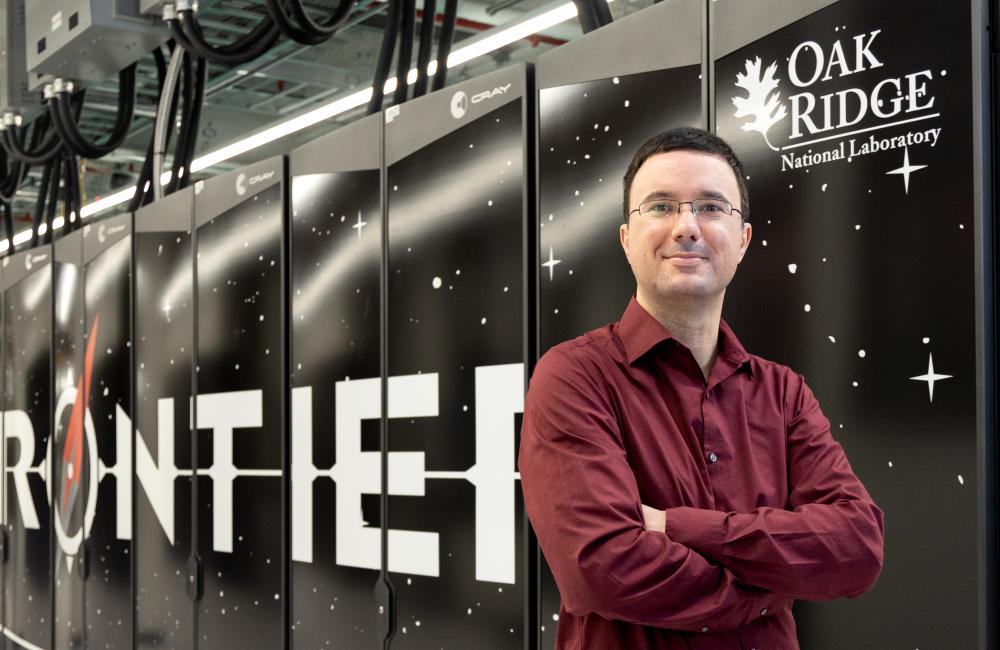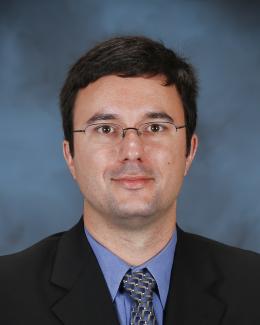Steven Hamilton. Credit: Genevieve Martin/ORNL, U.S. Dept. of Energy
As renewable sources of energy such as wind and sun power are being increasingly added to the country’s electrical grid, old-fashioned nuclear energy is also being primed for a resurgence.
For the past 20 years, fission reactors have produced a nearly unchanging portion of the nation’s electricity: around 20%. But that percentage could start increasing soon. The advent of small modular reactors, or SMRs, and advanced reactor concepts, or ARCs, signals a new generation of fission power. SMRs are substantially smaller than most commercial nuclear reactors today and use standardized designs, reducing construction costs and production time. Meanwhile, ARCs explore new technologies to produce fission power more efficiently and safely.
Exascale Small Modular Reactor, or ExaSMR for short, aims to provide the nuclear industry’s engineers with the highest-resolution simulations of reactor systems to date and, in turn, help advance the future of fission power. Supported by the Department of Energy’s Exascale Computing Project since 2016, the ExaSMR project endeavors to make large-scale nuclear reactor simulations easier to access, cheaper to run and more accurate than the current state of the art.
“By accurately predicting the nuclear reactor fuel cycle, ExaSMR reduces the number of physical experiments that reactor designers would perform to justify fuel use,” said Steven Hamilton, ExaSMR project leader and R&D scientist in the HPC Methods for Nuclear Applications Group at DOE’s Oak Ridge National Laboratory. “In large part, that’s what simulation is buying companies: a predictive capability that tells you how certain features will perform so that you don’t need to physically construct or perform as many experiments, which are enormously expensive.”
Coupling physics codes into a more powerful whole
Commercial nuclear reactors generate electricity by splitting uranium nuclei to release energy in a process known as fission. This energy turns water into steam, which spins electricity-producing turbines. ExaSMR integrates the most reliable computer codes available for modeling the physics of this operation, creating a toolkit that can predict a reactor design’s entire fission process. The toolkit includes Shift and OpenMC for neutron particle transport and reactor depletion and NekRS for thermal fluid dynamics.
Although most of these codes are already well established in science and industry, the ExaSMR team has given them a complete HPC makeover. For the past six years, researchers from ORNL, Argonne National Laboratory, the Massachusetts Institute of Technology and Pennsylvania State University have been optimizing the codes for a new generation of exascale-class supercomputers, such as ORNL’s Frontier and Argonne’s upcoming Aurora, which are accelerated by graphics processing units.
OpenMC’s development has been led by Paul Romano, and significant GPU-optimization work for Aurora has been conducted by John Tramm; the pair are computational scientists at Argonne. Shift was originally authored by Thomas Evans, group leader for ORNL’s HPC Methods for Nuclear Applications group, and is now optimized for Frontier. Both codes use Monte Carlo methods — computational techniques that use large numbers of random samples to calculate the probable outcomes of models. In this case, they simulate the interaction between neutrons moving through a nuclear reactor and nuclei, such as isotopes of uranium, thereby causing the fission that creates heat in the reactor’s fuel rods. The two codes also model how these isotopes evolve over time, which predicts the reactor’s life span.
NekRS — a computational fluid dynamics solver — describes how water will move and behave when heated by the reactor’s fuel cylinders. It was developed at Argonne through the ECP’s CEED project with contributions from Elia Merzari, associate professor of nuclear engineering at Penn State. The ExaSMR team’s ENRICO, for Exascale Nuclear Reactor Investigative Code, also developed by Romano, enables OpenMC and NekRS to interact.
“What we’re doing in ExaSMR is a coupled physics simulation between the neutron transport and the fluid dynamics — these two physics codes talk back and forth,” said ExaSMR project leader Hamilton. “The neutron transport is telling you where the heat is generated. That heat becomes a source term for the fluid dynamics calculation. The fluid dynamics calculates the temperature resulting from that heat source. And then you can adjust the parameters in the simulation until the neutron transport and the fluid dynamics are in agreement.”
ExaSMR’s ability to accurately model in high resolution the whole reactor process — the amount of heat the reactor’s fission events will produce, the ability of the reactor to transfer that heat to power generators, and the life expectancy of the entire system — provides engineers with key insights to ensure the safety and efficiency of their reactor designs.
What’s ahead for ExaSMR?
Partnering with Westinghouse, a producer of commercial nuclear power technology, the ExaSMR team applied for a DOE Office of Advanced Scientific Computing Research Leadership Computing Challenge grant. Westinghouse wants to evaluate the impact of using fuel enriched to higher levels of fissile uranium-235 than that currently used in its reactors. Running ExaSMR on Frontier will allow the company to perform high-fidelity simulations to predict how different types of fuels would perform if used in an operating reactor.
Likewise, Hamilton wants to apply ExaSMR to current ARC technologies being explored in the power industry, such as those being developed as part of the DOE Office of Nuclear Energy’s Advanced Reactor Demonstration Program. The program works with commercial companies to accelerate the demonstration of advanced reactors by providing initial funding. Two such reactors are slated for near-term deployment by 2027: X-energy’s Xe-100 pebble-bed reactor and TerraPower’s Natrium sodium-cooled fast reactor. Five additional designs from Kairos, Westinghouse, BWX Technologies, Holtec International and Southern Company are ramping up for longer-term deployment.
Hamilton foresees ExaSMR becoming an indispensable tool for companies entering a new era of nuclear power.
“Various companies are exploring different types of reactor designs today, and the high-performance, high-fidelity simulations that we’re developing have a lot of appealing features for designers,” he said. “It’s unlikely, in the near future, that we’ll have enough confidence in simulations that they would fully replace experiments, but if we can reduce the number of experiments that are performed, then there can be huge gains for these companies.”
UT-Battelle manages ORNL for DOE’s Office of Science, the single largest supporter of basic research in the physical sciences in the United States. DOE’s Office of Science is working to address some of the most pressing challenges of our time. For more information, visit https://energy.gov/science.




